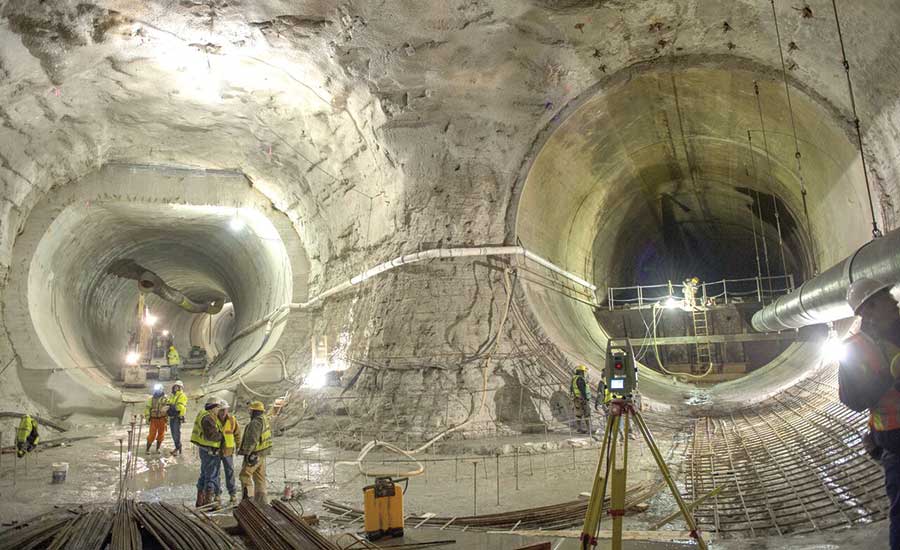Lets just say water and too much of it has been an issue for Chicagoland and still to some degree sometimes still.
It is problem that the city has been fighting/dealing with for centuries. We are still working on it though.
Who can forget the Great Chicago flood of 1992?
https://en.wikipedia.org/wiki/Chicago_flood
https://en.wikipedia.org/wiki/Tunnel_and_Reservoir_Plan
Tunnels and Reservoir Plan
The Tunnel and Reservoir Plan (abbreviated TARP and more commonly known as the Deep Tunnel Project or the Chicago Deep Tunnel)
is a large civil engineering project that aims to reduce flooding in the metropolitan Chicago area, and to reduce the harmful effects of flushing raw sewage into Lake Michigan by diverting storm water and sewage into temporary holding reservoirs.
The megaproject is one of the largest civil engineering projects ever undertaken in terms of scope, cost and timeframe. Commissioned in the mid-1970s, the project is managed by the Metropolitan Water Reclamation District of Greater Chicago. Completion of the system is not anticipated until 2029,but substantial portions of the system have already opened and are currently operational. Across 30 years of construction, over $3 billion has been spent on the project.
…
Surrounding farmland also engaged in flood control projects. The Illinois Farm Drainage Act of 1879 established drainage districts. These districts were generally named for the basin they drained—for example, the Fox River Drainage District. After World War II, suburban communities began to realize the benefits of separating stormwater from sewage water and began to construct separate sewer and storm drainage lines. The primary benefit of wastestream separation is that storm water requires less treatment than sewage before being returned to the environment.
Flood damage grew markedly after 1938, when surrounding natural drainage areas were lost to development and human activity. Serious flooding has occurred in the Chicago metropolitan area in the years 1849, 1855, 1885, 1938, 1952, 1954, 1957, 1961,1973, 1979, 1986, 1987, 1996,
Status
Phase 1, the creation of 109.4 miles (176.1 km) of drainage tunnels ranging from 9 to 33 feet (2.7 to 10.1 m) in diameter, up to 350 feet (110 m) underground, was adopted in 1972, commenced in 1975, and completed and operational by 2006.
Phase 2, reservoirs primarily intended for flood control, remains underway with an
expected completion date of 2029. Currently, up to 2.3 billion US gallons (8.7×109 l) of sewage can be stored and held in the tunnels themselves while awaiting processing at sewage treatment plants, which release treated water into the Calumet and Des Plaines rivers.
Additional sewage is stored at the
7.9-billion-US-gallon (30×109 l) Thornton Composite Reservoir, and the
350-million-US-gallon (1,300×106 l) Gloria Alitto Majewski Reservoir near O'Hare International Airport.
The 10-billion-US-gallon (38×109 l) McCook Reservoir is scheduled for completion in 2017 (3.5 billion US gallons (13×109 l)) and 2029 (6.5 billion US gallons (25×109 l)).
Because the reservoirs are decommissioned quarries, construction has been delayed by decreased demand for the quarried gravel.
Upon completion, the TARP system will have a capacity of 17.5 billion US gallons (66×109 l) of storage
On October 3, 1986, a heavy thunderstorm drenched the southern portion of the Deep Tunnel area with several inches of rain in a short period of time. While the Deep Tunnel system performed satisfactorily by absorbing excess water, water within the system itself rushed past the north side of Chicago and near the
Bahá'í Temple in Wilmette.
Geysers of over
65 feet (20 m) were reported in both locations for up to an hour as the water was redistributed more evenly through the system.
A 30 ft (9 m) geyser erupted downtown at the corner of Jefferson and Monroe. A system of watertight bulkheads has since been installed to prevent the event from occurring again.
During the Chicago Flood of 1992, the water from the Chicago River that leaked into the long-disused underground freight tunnel system was eventually drained into the Deep Tunnel network, which itself was still under construction.

Good photos of the reservoir in the link below.
http://interactive.wbez.org/photos/deeptunnel/
After 40 years, Chicago's Calumet Deep Tunnel project is complete
The Thornton Reservoir is the final stage of the TARP tunnel project's Calumet branch. When the former limestone quarry fills, it will add 7.9 billion more gallons of capacity to Chicago’s stormwater runoff system.
 http://gapersblock.com/mechanics/201...ornton-quarry/
http://gapersblock.com/mechanics/201...ornton-quarry/




